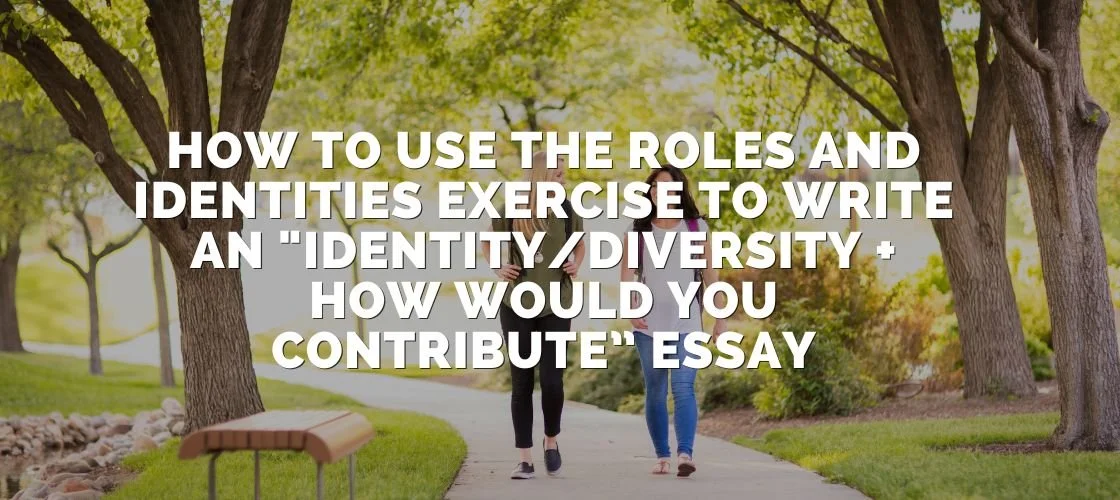Essay prompts revolving around Identity or Diversity or “How will you contribute to X campus?” have become increasingly common in the past few years, in part possibly because of the Supreme Court’s decision limiting the use of race in admissions decisions.
And these kinds of prompts can confuse plenty of students.
So below, we’ll talk through a way to approach these that can help virtually any student show how their identities and experiences can contribute to a college campus and community.
TABLE OF CONTENTS
(click to skip ahead)First, what do I mean by an “identity/diversity + How would you contribute?” essay?
Broadly speaking, we’re talking about essay prompts that look like this:
How has your life experience contributed to your personal story—your character, values, perspectives, or skills—and what you want to pursue at Hopkins? (350 word limit)
Or this:
Northwestern is a place where people with diverse backgrounds from all over the world can study, live, and talk with one another. This range of experiences and viewpoints immeasurably enriches learning. How might your individual background contribute to this diversity of perspectives in Northwestern’s classrooms and around our campus? (200 words)
Or this:
Students entering Brown often find that making their home on College Hill naturally invites reflection on where they came from. Share how an aspect of your growing up has inspired or challenged you, and what unique contributions this might allow you to make to the Brown community. (200-250 words)
Note: Sometimes colleges and universities will use the word “identity,” sometimes “diversity,” and sometimes both (thus the perhaps awkward-seeming title of this blog).
Here’s the first major point we want to make about this type of prompt:
If you assume that you (as a student) are being asked to…
1) Choose one or more parts of yourself you’d like to show, and then
2) Connect that/those part(s) of you to specific opportunities at the college or university you’re writing for
…then this can work for a whole BUNCH of different supplemental essays for college.
How do we know?
Because, in preparation for writing this guide, we analyzed hundreds of prompts, and discovered that the approach we cover here will work for many kinds of essays.
(Heads-up: In Part 2 of this guide we’ll cover: What other prompts could this approach work for?)
Why is this type of essay important?
A lot of colleges and universities ask for a version of this prompt, so if you choose to write it, it’s likely to become a very useful Super Essay for your application (read: an essay that can work for multiple different prompts). So…
We’re going to suggest you probably write this essay.
Why?
You will probably save time.
You will probably produce better writing.
In fact, we’ll go one step further and say: If you’re given the option, probably choose this type of prompt.
Here’s what we mean by that: Sometimes schools will give you the option to write either:
a) an essay that looks like the essay we’re describing in this guide (i.e., Who are you + How would you contribute to our campus), or
b) a different (usually more niche topic / less reusable) essay.
…and we want to advocate for you choosing this type of essay.
Why?
Because not only can you reuse it (as above), but you’ll also likely be able to show you’re a great fit, demonstrate interest, and as a result maybe even raise your chances of getting in.
All right, let’s get into the practicals.
How to Write the “Identity + How would you contribute” Essay
Broadly speaking, here’s what you’re trying to show in this type of essay:
How this works, in brief:
Pick 5 roles/identities you might like to show in your application.
Research yourself: How have you developed these sides of yourself?
(Optional but recommended: Complete the “If you really, really knew me” exercise)
Research college(s): How might each of these sides of yourself be able to thrive on the college’s campus?
Pick one or more identities to focus on, then connect each one to specific opportunities the college/university has to offer.
Let’s break that down…
Disclosure: For steps 1-3, I’m going to borrow pieces from my guide on How to Use the Roles and Identities Exercise to Write a “Why us” Essay because some parts overlap.
Step 1: Pick 5 roles or identities you might like to show in your application.
Go to this link and pick 10 identities you might like to show, then whittle it down to a top 5.
Not sure which ones to pick? Two tips:
Try to show different sides of yourself by grouping identities. You might notice that “creator” and “artist” can be grouped together, for instance. So maybe pick one to represent both, so you free up a spot in your top 5.
Consider identities that might demonstrate some of the following qualities:
Intellectual curiosity
Service to others
Leadership or initiative
Collaboration
Consistent engagement
Why? Because these are what we call “Admissions nutrients” that just about every college you’re likely applying to is looking for in applicants.
Step 1B (optional, but encouraged): Complete the “If You Really, Really Knew Me” Exercise.
This is an upleveled, more specific version of the Everything I Want Colleges to Know about Me exercise.
It takes some time, but it’s incredibly useful for generating content.
In fact, some counselors use this as the document they have students fill out so they can write even better recommendation letters (And counselors reading this: Feel free to do so, just please leave the CEG logo on there).
Students: If you spend 1-2 hours on this exercise, you will have plenty to include in lots of your essays.
Once you’ve done that…
STEP 2. Name 2-5 examples of how each role/identity you chose in Step 1 manifests in your life (aka “research yourself”).
The more specific your examples are the better.
Examples for a “maker” identity:
Kinda’ specific (good): I’m a maker when I’m creating in my makerspace, robotics club, or baking.
More specific (better): I thrive as a maker when I’m using an Arduino to create a color-changing lamp in the makerspace in my garage, or using CAD software to design a robotic arm that can interact with game pieces, or when I’m tweaking the ingredients for my grandfather’s sourdough recipe.
Examples for a “critical thinker” identity:
Kinda’ specific (good): I’m a critical thinker when I’m thinking about philosophy or debate.
More specific (better): I like thinking critically when I’m researching Neo-Confucianism for a philosophy class project, or studying Protagoras’ antilogic and Dissoi Logoi in preparation for a switch-side policy debate.
Note: We think it’s not a bad idea to research yourself first, then the college(s) second, as we’ve found that students who know what they want are more likely to spot things they’re interested in when they’re researching colleges.
Having said that, we’ve also seen it work the other way around: It could be that, while you’re researching, you spot an interesting program that helps you realize This Is What You’ve Been Searching for All Along.
Be open to both possibilities.
3. Research how each of these identities might thrive on the campus of the college(s) you’re applying to.
How do you research this part?
Check out the advice in this guide in the section called “How to Find All the Resources You Need to Learn about a Particular School.”.
4. Pick one or more identities to focus on, then connect each one to specific opportunities the college/university has to offer.
How many identities you choose will depend on the word limit, but we’d say if the prompt asks for 250 words or less, 1-3 identities should work.
If it’s 500 words or more, you could probably get away with 4-5 identities (but hey, 2-3 that you go deeper on are fine too).
How do you choose? Pick identities that aren’t already coming through clearly in the personal statement or any other supplemental essays for this particular school. If you like, consider choosing identities that might help you weave in admission nutrients.
Let’s see what these look like in the wild:
Example Essay #1 for the “How would you contribute?” prompt
Prompt from 2024 (hey: look up the most recent prompts on the Common App): Bowdoin believes that only through building a more diverse and inclusive campus community will the College best prepare graduates to be contributing and useful citizens of the world. Every graduate of this institution should be confident in their preparation to be able to navigate through differences and in all sorts of situations. A Bowdoin education does not guarantee these skills, but it does impart a set of tools necessary to bravely enter unfamiliar conditions with the confidence to deal effectively with ambiguity. If you wish, you may share anything about the unique experiences and perspectives that you would bring with you to the Bowdoin campus and community or an experience you have had that required you to navigate across or through difference.
Example:
I believe in the power of small acts of service. After witnessing the plight of Middle Eastern migrant workers left at sunrise in desert mountains with nothing but a broom, a bottle of water, and a single meal to last the day, I felt helpless. Globalization often comes at the cost of thousands of immigrant lives, but the realization that there was little I could do to ease their anguish affected me deeply. In that moment, I found my calling as an advocate.
Analysis: This student chooses to focus on one identity: advocate. And their essay structure is kind of an origin story (yup, like a superhero/Marvel movie).
The author begins with what screenwriters call the Inciting Incident (i.e., the moment that started it all)—in this case, the moment that inspired the author to take action—which helps draw us in.
Structurally, notice how the author shares
what they witnessed
how it impacted them
why it impacted them, and
a statement of resolve (decision to do something about it).
Q to consider as you’re exploring your own essays: Was there a moment for you that started it all? What was your Inciting Incident, if there was one?
When I returned home, I was determined to give back to my own community. Working at the NJ Help Center has enabled me to spend a lot of time with immigrant families like mine, translating applications for housing aid and health insurance while immersing myself in stories of their escapes from war-torn countries and crippling economies. Soon, I realized how great an impact small exchanges could have.
Analysis: Here the author highlights specific actions they took as a result of what they witnessed, and again shares the impact it had on their thinking.
Note that even though this particular activity may have been mentioned in their Activities List, one of the important values of your supplemental essays is to bring to life and give context to these experiences.
Q to consider: How did your extracurricular activities impact you? Could you use your supplemental essay(s) to include details and information about your “why” that isn’t and can’t really be shown in your Activities List?
Okay, check out the turning point moment in the essay…
At Bowdoin, I’ll continue to work towards building a community for myself and others. By joining fEMPOWER, I can work alongside peers to directly engage with social justice issues and increase female representation on campus and beyond. Through the Muslim Student Alliance, I hope to facilitate interfaith dialogue. And as a dad jokes connoisseur who thrives on improv, I can’t wait to spread laughter and joy across campus.
And some day, in addition to becoming a universal helping hand, I hope to become the first hijabi U.S. Ambassador to the United Nations, a journey I embarked on at Bowdoin.
Analysis: We love how this author includes specific opportunities available at Bowdoin: fEMPOWER and the Muslim Student Alliance. (We’ve bolded them above, but you don’t need to highlight these in your final submission.)
The author doesn’t just mention these on their own, however, or simply say “...and these seem great!” Instead, the author includes specific language about how they’ll engage with these opportunities and how they’ll contribute:
“By joining fEMPOWER, I can work alongside peers to directly engage with social justice issues and increase female representation on campus and beyond” and
“Through the Muslim Student Alliance, I hope to facilitate interfaith dialogue.”
Example Essay #2 for the “How would you contribute?” prompt
Prompt: A hallmark of the Columbia experience is being able to learn and live in a community with a wide range of perspectives. How do you or would you learn from and contribute to diverse, collaborative communities? (200 words)
Example:
I'm a non-binary neuromarketing nerd, a Renaissance Being at heart. At Columbia, I’d found a neuromarketing club to introduce this emerging field to peers, join the Queer Alliance, cook traditional Estonian sauerkraut for my roommates at Christmas, and join the Chinese Calligraphy club to expand my repertoire and teach others the rare scripts I’ve learned.
Analysis: This student names their identity right at the start—”non-binary neuromarketing nerd, a Renaissance Being at heart”—which works well. This identity naming is a bit more complex than the first example, because the identity has multiple parts. It’s also intriguing, making us wonder what each of these labels means, so it serves as a nice hook, too.
The author then goes straight into Columbia-specific opportunities that relate to their interests, which works.
And heads up: Neither this approach nor the approach above is necessarily “better”; both work well.
Most significantly, I’d draw from my experience with the Human Library Organization where I’m a book [that] curious people read to learn about embracing stigmatized gender identities. By conducting conversations with international readers, I help ensure non-binary people are not only recognized but celebrated. At Columbia, I’d love to arrange a Human Library event on campus, empowering any minoritized students (international, of color, first generation, neurodivergent, etc.) with a platform to share and process their experiences, simultaneously giving me and others a chance to learn from them. Estonia is 99% white, so I’m particularly eager to learn from non-white students in a safe space promoting open dialogue. A mini version would also make a fun addition to the Queer Alliance’s LGBTQ+ fall mixer and contribute a new way of embracing each others’ cultural differences, ultimately fostering a more cohesive and dynamic community on campus.
Analysis: This paragraph is loaded with great, specific details about the school and how the student will engage with the community.
Key element: Notice that every single detail about Columia has a “so what”—a specific mention of why this is important to the student and how they want to engage. For example: “empowering any minoritized students (international, of color, first generation, neurodivergent, etc.) with a platform to share and process their experiences, simultaneously giving me and others a chance to learn from them.”
FYI: We’re keeping these analyses short so this guide doesn’t get suuuuuper long. (And yeah, it’s already kinda pretty long…)
Part 2: Other prompts this approach can work for:
The “Why us” Essay
The “Why us” essay is basically already taking this approach. But for more on this, click here.
The “Extracurricular” Essay
This approach could work for a prompt like this one:
Briefly describe any of your extracurricular activities, employment experience, travel, or family responsibilities that have shaped who you are. (10-150 words)
How it works:
Devote most of the word limit to answering the prompt. Then include a final sentence that mentions a specific opportunity the college offers.
Example essay (shortened version of the “advocate” essay above for Bowdoin):
I believe in the power of small acts of service. After seeing Middle Eastern migrant workers abandoned in desert mountains with only a broom, water, and one meal, I felt helpless—but that’s when I found my calling as an advocate. Back home, I began volunteering at the NJ Help Center, supporting immigrant families like mine. I translated applications for housing aid and health insurance, listening to stories of escape from war and economic hardship. These small exchanges reminded me how meaningful direct service can be. At Bowdoin, I’ll continue building community through fEMPOWER—working to elevate female voices—and the Muslim Student Alliance, where I’ll foster interfaith dialogue. One day, I dream of becoming the first hijabi U.S. Ambassador to the United Nations—a journey I know begins with small acts, genuine connection, and a commitment to justice. That journey, I believe, starts at Bowdoin.
Brief analysis: Note the one sentence “Why us” that’s woven in. Does the college ask for it? No. But why not take the opportunity to show you’ve done your research and how you might contribute to the campus community?
The “Intellectual Curiosity” Essay
Some colleges will straight up ask for the “How will you contribute” part in their “Intellectual Curiosity” prompt. Take Haverford’s prompt from 2024, for instance:
Tell us about a topic or issue that sparks your curiosity and gets you intellectually excited. How do you hope to engage with this topic or issue at Haverford? (200 words.)
Some colleges won’t ask for the “How will you contribute” piece explicitly. Take Tuft’s prompt from 2024:
It’s cool to love learning. What excites your intellectual curiosity and why? (250 words)
But hey, it’s not a terrible idea to weave it in anyway, especially if you do two things:
answer the prompt first, and
keep the mention brief.
Like this:
Diseases intrigue me more than anything. My interest started in sixth grade when I learned about a small Ebola outbreak in West Africa. Every day I’d go straight home from school and Google news articles about the outbreak. Ebola both terrified and fascinated me. My sixth-grade self worried the outbreak would consume the entire region and never stop spreading. I was fascinated by how such a small virus could cause such irreparable damage. The methods Doctors Without Borders and the WHO employed to try and contain the virus also caught my attention. I noted what worked and what didn’t, and was surprised by the lackluster global response to the outbreak.
My interest in Ebola led me to studying other diseases. After studying Zika, MERS, Nipah, and hemorrhagic diseases such as Lassa Fever, I’ve realized that the world is grossly underprepared for the next pandemic.
Whether I’m petitioning governments or researching vaccines, I want to help prepare the world for the next pandemic. That’s why Tufts’ Community Health program, with electives like Health, Disease, and the Environment, feels like a perfect fit—I’m especially curious about how environmental change accelerates zoonotic spillover. I’m also drawn to the Global Health Collaborative, where I hope to contribute to a student-led research project on disease surveillance infrastructure in low-income countries.
Whether I am petitioning world governments or researching new vaccines, I want to help prepare the world for the next pandemic. That's why I want to study and raise awareness about diseases as an epidemiologist.
Brief analysis: This works well because, again, the author has answered the prompt and the mention of school-specific details are brief.
And, in case you’re wondering: You don’t HAVE to do this. You don’t have to turn every single essay into a “Why us” essay. But hey, if a college doesn’t have a “Why us” (or other similar essay that asks why you’re interested in their campus), I think it’s not a bad idea to weave it in.
The "Why Major” Essay
Notice how everything in the “Intellectual Curiosity” essay example above could apply to a “Why major” essay. The essay could even work almost as is; the author might just want to change 1-2 sentences to say “that’s why I want to major in X,” and expand just a bit.
The “Community” Essay
Some universities ask about your involvement with community, often with some version of this:
Everyone belongs to many different communities and/or groups defined by (among other things) shared geography, religion, ethnicity, income, cuisine, interest, race, ideology, or intellectual heritage. Choose one of the communities to which you belong, and describe that community and your place within it. (300 words)
For this type of essay, we’d say clearly answer the prompt first.
Then if you want to (and you don’t have to), you might consider adding 1-3 sentences naming specific opportunities at the college or university you’re applying to.
As an example, take a look at the “storyteller” community example on our Community Essay guide, which ends:
I love to perform with my theatre class to entertain and educate young audiences throughout my community. To tell our stories, we travel to elementary and middle schools performing plays that help educate younger students of the dangers of drugs, alcohol, and bullying. As storytellers, we aim to touch lives and better the world around us through our stories.
Note how then the author could have simply continued with something like:
…That’s why I’m interested in [X particular course, program or extracurricular activity] at [Y college / university] as I hope to better understand [Z particular thing].
We could go on and on, giving examples of essay prompts that focus on everything from leadership to social issues to service, but you get the idea here.
Key Takeaways:
If you have an opportunity to choose this type of essay, probably take it (see reasons above).
It’s not a bad idea to weave in some school-specific details at the end of your essay a) if you’ve answered the prompt, and b) if you keep the mention(s) brief.
You can do this with many types of supplemental essays.
Ethan Sawyer (he/him) has been eating/sleeping/breathing college essays for most of his waking hours since 2003. He is an internationally recognized college essay and admissions expert and the author of the Amazon bestsellers College Essay Essentials and College Admission Essentials. Ethan’s educational experiences, reading, and training have informed his deep interest in storytelling as a vehicle for personal development and growth. With a passion for access and equity, Ethan has provided quality resources for students, families, and professional communities alike. He has supported thousands of students through the complicated college search and application process, all while staying true to his core values of providing ease, purpose, and joy in the process.












